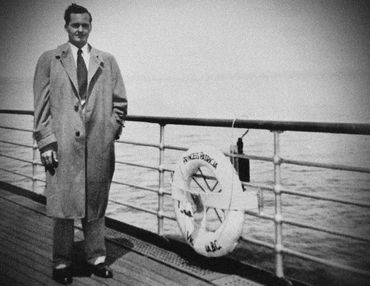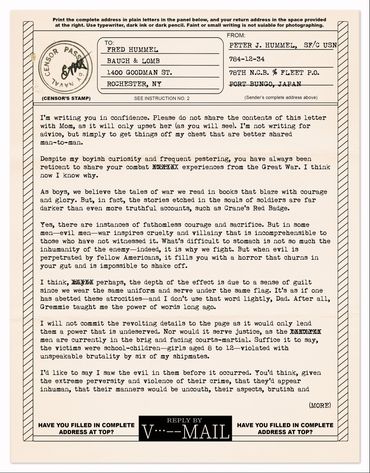A WORD ABOUT P.J. HUMMEL

WHO IS P.J. HUMMEL?
According to the biographical endnote in Gingerland, Peter James “P.J.” Hummel (b. 21 February 1927, d. 2 December 1954) was an American journalist, writer, and lyricist born in St. Cloud, Minnesota, the son of a local businessman, Frederick Hummel, and his wife, Julia, a schoolteacher.
The Hummel family later moved to Rochester, New York, where P.J. obtained employment at the Post-Bulletin and learned the typesetting trade. After serving a brief tour with the United States Navy, Hummel attended the University of Chicago, studying business and economics with a minor in creative writing.
Hummel’s first novel, Gingerland, based on stories told to him by his grandmother, Dorothy Sandburg, was published in October 1953. Thanks to its popularity, it was translated into no less than 16 languages. Gingerland also earned significant critical acclaim along with brisk sales worldwide.
Hummel succumbed to tuberculosis in Duarte, California in 1954.
ARCHIVAL MATERIAL:









P.J. HUMMEL: LOST AND FOUND
A short documentary detailing the life of Gingerland author P.J. Hummel and the legacy of his creation.
IN FACT:
P.J. Hummel never existed at all—except in the imagination of Gingerland creator, Daniel Knauf.
SO HE'S JUST A PSEUDONYM?
No.
According to Knauf, P.J. Hummel is much, much more than a name on the title page; he played an essential role in the creative process of writing Gingerland.
In a sense, he is very much the book's actual author.
HOW SO?
Knauf is an accomplished screenwriter. As a show-creator for series television like HBO's CARNIVALE and Nickelodeon's THE ASTRONAUTS, he constructs complex, detailed worlds. As a dramatist, he composes dialogue spoken by a wide variety of characters—some of whom he has created; many created by other artists.
Knauf, however, was decidedly not an accomplished novelist.
In fact, Gingerland was his first novel.
Once he decided to write it as a book rather than a screenplay, he struggled for months to find his author's "voice."
Although he had written in the voices of dozens of characters over the course of his career—from Spartacus to Tony Stark in Marvel's Iron Man comics to Red Reddington in NBC's THE BLACKLIST—he had never written in his own voice.
Thus was born P.J. Hummel.
WHAT THEN?
Knauf created Hummel as an amalgam of his favorite children's book authors—Raold Dahl, Lewis Carroll, A.A. Milne, Dr. Seuss—various writers and filmmakers who have influenced him as an artist—Tolkien, Lynch, Bradbury, Richard Matheson, Vonnegut, William Goldman—as well as interesting people he's met and, finally, his father, John Henry Knauf.
In fact, the man appearing as P.J. Hummel in photos is actually Knauf's dad. The two even share a birthday and numerous biographical details.
He also invented the people in Hummel's life; his family, friends and mentors—especially his cherished Norwegian "Gremmie," Dorothy Sandburg, a former competitive figure skater who not only told her young grandson P.J. the stories of Gingerland, but served as inspiration for Emmet C. W. Candleworth's mother in the book.
WHAT WAS HIS PROCESS?
Knauf composed exhaustive biographical details for Hummel, including the archival materials reproduced in the above gallery. This technique he has used in his TV series world-building helped him actualize Hummel as a living, breathing person.
What was P.J. Hummel's point of view?
What made him laugh?
What scared him?
What was important to him?
Where did he grow up? Go to school?
What were his goals? His strengths? His weaknesses?
What were his values?
The answers to these questions enabled Knauf to define how Hummel approached the story and how he would tell it—the rhythm of his prose, the attitude of the narrative and its primary themes.
PUTTING IT TOGETHER
A key aspect of Hummel's character was his training as a journalist, which imbued him with a wisecracking cynicism, and his experiences in Post WWII Japan. Both these characteristics lent some weight and grit to the feckless small-town American boy, born in the Heartland and raised in Rochester, NY.
The human tragedies he witnessed overseas during the occupation of Japan instilled an abiding reverence for the fragility of human life, especially children.
In short, the tough newspaperman and Navy vet had a soft spot for kids.
This, more than anything, is what motivated P.J. Hummel to write Gingerland.
ADDITIONAL CONSIDERATIONS
Knauf conceived Gingerland as an homage to the children's chapter books that inspired him as a child growing up in the 1960s. His intent was to create a book that was not only a heartfelt and original Christmas story, but was imbued with a sense of timelessness.
His objective was to create not only a book, but to inspire a new family tradition that taps into the magical storytelling tradition of adults reading aloud to children—in this case, over the four nights leading up to Christmas Eve.
To that end, Knauf collaborated closely with his illustrator, Zelda Devon, to create images that hearkened back to the classic work of artists such as Arthur Rackham, Beatrix Potter, Ernest H. Shepard and Johnny Gruelle.
Zelda happily set aside her digital pad and broke out pens, brushes and paint to create the wonderful, distinctly analogue images within the book.
One of the reasons Knauf decided to attribute authorship to P.J. Hummel was in keeping with the vintage theme of Gingerland's look and feel, presenting the illusion it was created in a bygone age—specifically, mid-20th-century America.
WHY KILL P.J. OFF?
Perhaps to lend Gingerland a whiff of tragedy? To explain why, despite its positive reception and glowing reviews, the book fell out of print and became a "lost classic?"
From a pragmatic standpoint, P.J. Hummel was born in 1927 and it is very unlikely he'd be alive today (he was, after all a pack-a-day smoker. Lucky Strikes.)
Nevertheless, Knauf confesses that he's not sure exactly why he chose to kill off Hummel."It just felt right," he says. "Sometimes, when you're making it up as you go along—which is pretty much my job description—you have to go with your gut."
This site uses cookies.
We use cookies to analyze website traffic and optimize your experience with our site. By accepting our use of cookies, your data will be aggregated with everyone's data.
